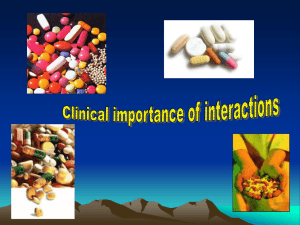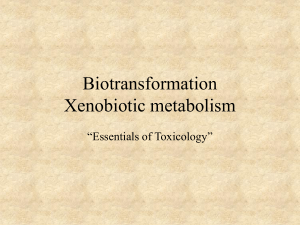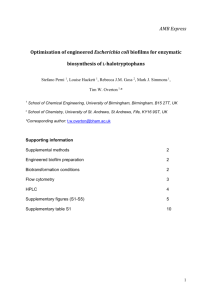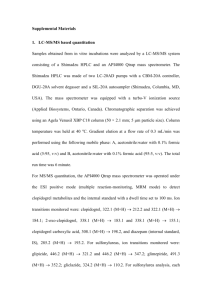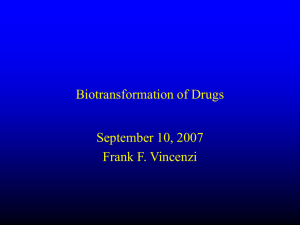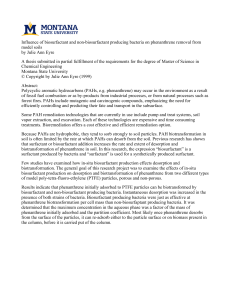Fengyan Liu , Steve Wiseman , Markus Hecker , Yi Wan
advertisement
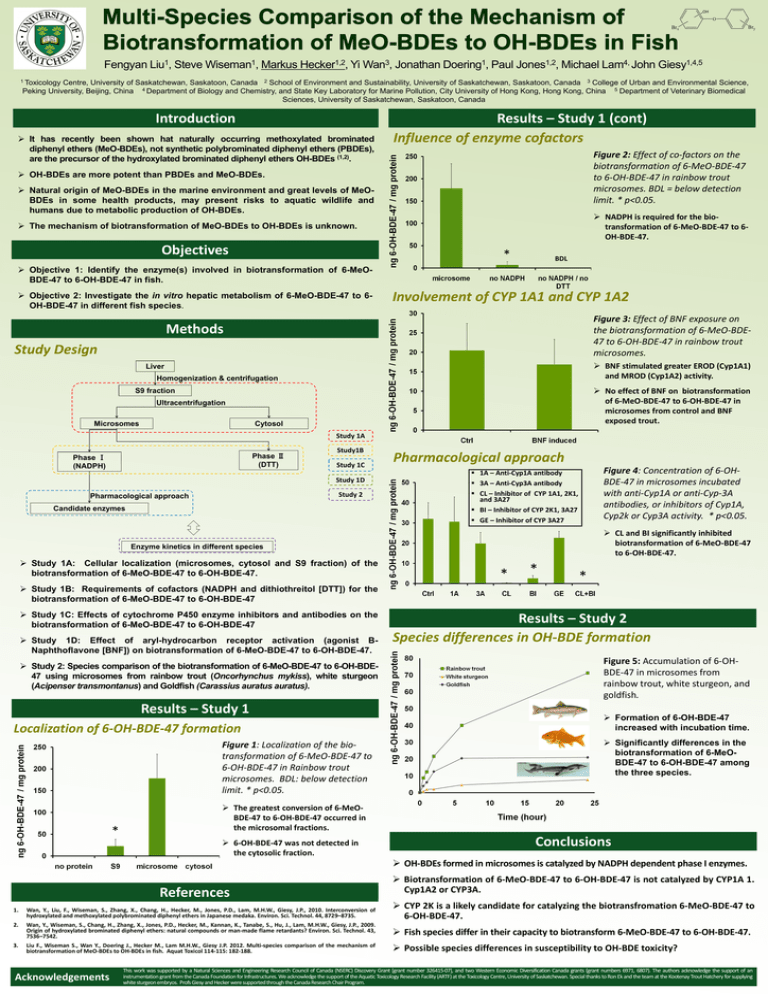
OH O Brx Bry Fengyan Liu1, Steve Wiseman1, Markus Hecker1,2, Yi Wan3, Jonathan Doering1, Paul Jones1,2, Michael Lam4, John Giesy1,4,5 1 Toxicology Centre, University of Saskatchewan, Saskatoon, Canada 2 School of Environment and Sustainability, University of Saskatchewan, Saskatoon, Canada 3 College of Urban and Environmental Science, Peking University, Beijing, China 4 Department of Biology and Chemistry, and State Key Laboratory for Marine Pollution, City University of Hong Kong, Hong Kong, China 5 Department of Veterinary Biomedical Sciences, University of Saskatchewan, Saskatoon, Canada Introduction It has recently been shown hat naturally occurring methoxylated brominated diphenyl ethers (MeO-BDEs), not synthetic polybrominated diphenyl ethers (PBDEs), are the precursor of the hydroxylated brominated diphenyl ethers OH-BDEs (1,2). Results – Study 1 (cont) Influence of enzyme cofactors Figure 2: Effect of co-factors on the biotransformation of 6-MeO-BDE-47 to 6-OH-BDE-47 in rainbow trout microsomes. BDL = below detection limit. * p<0.05. OH-BDEs are more potent than PBDEs and MeO-BDEs. Natural origin of MeO-BDEs in the marine environment and great levels of MeOBDEs in some health products, may present risks to aquatic wildlife and humans due to metabolic production of OH-BDEs. NADPH is required for the biotransformation of 6-MeO-BDE-47 to 6OH-BDE-47. The mechanism of biotransformation of MeO-BDEs to OH-BDEs is unknown. Objectives * BDL Objective 1: Identify the enzyme(s) involved in biotransformation of 6-MeOBDE-47 to 6-OH-BDE-47 in fish. Objective 2: Investigate the in vitro hepatic metabolism of 6-MeO-BDE-47 to 6OH-BDE-47 in different fish species. Involvement of CYP 1A1 and CYP 1A2 Figure 3: Effect of BNF exposure on the biotransformation of 6-MeO-BDE47 to 6-OH-BDE-47 in rainbow trout microsomes. Methods Study Design BNF stimulated greater EROD (Cyp1A1) and MROD (Cyp1A2) activity. Liver Homogenization & centrifugation No effect of BNF on biotransformation of 6-MeO-BDE-47 to 6-OH-BDE-47 in microsomes from control and BNF exposed trout. S9 fraction Ultracentrifugation Microsomes Cytosol Study 1A Phase Ⅱ (DTT) Phase Ⅰ (NADPH) Study1B Study 1C Study 1D Study 2 Pharmacological approach Candidate enzymes Pharmacological approach Figure 4: Concentration of 6-OHBDE-47 in microsomes incubated with anti-Cyp1A or anti-Cyp-3A antibodies, or inhibitors of Cyp1A, Cyp2k or Cyp3A activity. * p<0.05. 1A – Anti-Cyp1A antibody 3A – Anti-Cyp3A antibody CL – Inhibitor of CYP 1A1, 2K1, and 3A27 BI – Inhibitor of CYP 2K1, 3A27 GE – Inhibitor of CYP 3A27 CL and BI significantly inhibited biotransformation of 6-MeO-BDE-47 to 6-OH-BDE-47. Enzyme kinetics in different species Study 1A: Cellular localization (microsomes, cytosol and S9 fraction) of the biotransformation of 6-MeO-BDE-47 to 6-OH-BDE-47. Study 1B: Requirements of cofactors (NADPH and dithiothreitol [DTT]) for the biotransformation of 6-MeO-BDE-47 to 6-OH-BDE-47 Study 1C: Effects of cytochrome P450 enzyme inhibitors and antibodies on the biotransformation of 6-MeO-BDE-47 to 6-OH-BDE-47 Study 1D: Effect of aryl-hydrocarbon receptor activation (agonist BNaphthoflavone [BNF]) on biotransformation of 6-MeO-BDE-47 to 6-OH-BDE-47. Study 2: Species comparison of the biotransformation of 6-MeO-BDE-47 to 6-OH-BDE47 using microsomes from rainbow trout (Oncorhynchus mykiss), white sturgeon (Acipenser transmontanus) and Goldfish (Carassius auratus auratus). Results – Study 1 Localization of 6-OH-BDE-47 formation Figure 1: Localization of the biotransformation of 6-MeO-BDE-47 to 6-OH-BDE-47 in Rainbow trout microsomes. BDL: below detection limit. * p<0.05. * The greatest conversion of 6-MeOBDE-47 to 6-OH-BDE-47 occurred in the microsomal fractions. 6-OH-BDE-47 was not detected in the cytosolic fraction. References 1. Wan, Y., Liu, F., Wiseman, S., Zhang, X., Chang, H., Hecker, M., Jones, P.D., Lam, M.H.W., Giesy, J.P., 2010. Interconversion of hydroxylated and methoxylated polybrominated diphenyl ethers in Japanese medaka. Environ. Sci. Technol. 44, 8729–8735. 2. Wan, Y., Wiseman, S., Chang, H., Zhang, X., Jones, P.D., Hecker, M., Kannan, K., Tanabe, S., Hu, J., Lam, M.H.W., Giesy, J.P., 2009. Origin of hydroxylated brominated diphenyl ethers: natural compounds or man-made flame retardants? Environ. Sci. Technol. 43, 7536–7542. 3. Liu F., Wiseman S., Wan Y., Doering J., Hecker M., Lam M.H.W., Giesy J.P. 2012. Multi-species comparison of the mechanism of biotransformation of MeO-BDEs to OH-BDEs in fish. Aquat Toxicol 114-115: 182-188. Acknowledgements * * * Results – Study 2 Species differences in OH-BDE formation Figure 5: Accumulation of 6-OHBDE-47 in microsomes from rainbow trout, white sturgeon, and goldfish. Formation of 6-OH-BDE-47 increased with incubation time. Significantly differences in the biotransformation of 6-MeOBDE-47 to 6-OH-BDE-47 among the three species. Conclusions OH-BDEs formed in microsomes is catalyzed by NADPH dependent phase I enzymes. Biotransformation of 6-MeO-BDE-47 to 6-OH-BDE-47 is not catalyzed by CYP1A 1. Cyp1A2 or CYP3A. CYP 2K is a likely candidate for catalyzing the biotransfromation 6-MeO-BDE-47 to 6-OH-BDE-47. Fish species differ in their capacity to biotransform 6-MeO-BDE-47 to 6-OH-BDE-47. Possible species differences in susceptibility to OH-BDE toxicity? This work was supported by a Natural Sciences and Engineering Research Council of Canada (NSERC) Discovery Grant [grant number 326415-07], and two Western Economic Diversification Canada grants (grant numbers 6971, 6807). The authors acknowledge the support of an instrumentation grant from the Canada Foundation for Infrastructures. We acknowledge the support of the Aquatic Toxicology Research Facility (ARTF) at the Toxicology Centre, University of Saskatchewan. Special thanks to Ron Ek and the team at the Kootenay Trout Hatchery for supplying white sturgeon embryos. Profs Giesy and Hecker were supported through the Canada Research Chair Program.

